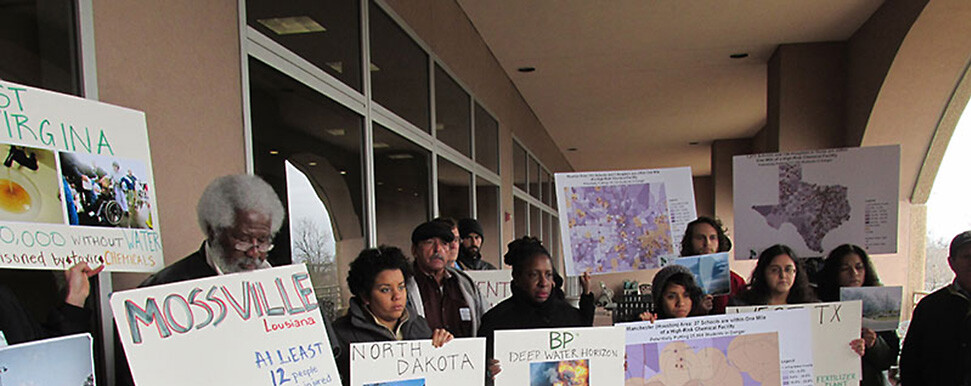
Media
February 17, 2016Environmental Justice Advocates Celebrate Victory as Lawsuit Settlement Directs EPA to Protect Communities from Chemical Spills
February 17, 2016 - Today, the Environmental Protection Agency (EPA) settled a lawsuit brought by the Environmental Justice Health Alliance (EJHA) and its allies, and agreed to finally implement a 40-year old Congressional mandate to protect communities from industrial chemical spills. Environmental justice advocates, community leaders, and EJHA allies, including the Natural Resources Defense Council (NRDC) and People Concerned About Chemical Safety (PCACS), celebrated the victory, and issued the following comments:
“This is a tremendous victory for at-risk communities across the nation, but millions of people—who are disproportionately low-income and people of color—have had their water polluted while EPA ignored its mandate to protect the public,’’ said Richard Moore of Albuquerque, N.M., co-coordinator of the Environmental Justice Health Alliance for Chemical Policy Reform (EJHA), a nationwide environmental justice grassroots network. “While the four decade delay is troubling, at last our communities can look forward to EPA providing these protections.”
“Recent events have fueled tremendous public concern about the health and safety of the drinking water we all depend on,” said Michele Roberts, co-coordinator of EJHA. “Given the unbearable situations people from Charleston, WV, Flint, MI, Baltimore, MD, Hoosick Falls, NY and dozens of other communities face, today's action by EPA is a long-awaited and much needed step toward protecting our drinking water from chemical contamination. We look forward to working with EPA to ensure that communities across the nation, and especially low-income and people of color communities, receive the safeguards for their drinking water that they deserve.”
“It is unfortunate that it took a lawsuit to get EPA to agree to set spill prevention rules,’’ said Pam Nixon, the spokesperson for PCACS, a community organization based in West Virginia’s heavily industrial Kanawha Valley. In 2014, communities in the Kanawha Valley experienced our nation's most significant hazardous chemical spill in recent memory, when over 10,000 gallons of a chemical used to process coal leaked into Charleston's drinking water supply. The contamination deprived nearly 300,000 citizens access to clean tap water for a week. Pam Nixon continued: “Uniform federal safeguards for above-ground storage tanks and secondary containment will better protect not only public drinking water systems, but also the groundwater for households using private wells.
“It’s long past time for EPA to protect the health of residents near these industrial sites, and we urge the agency to adopt strong, protective standards to prevent future spills,” said Erik Olson, Director of the Health Program at NRDC.
The settlement between the groups and EPA, approved by the federal district court for the Southern District of New York, requires EPA to begin a rulemaking process immediately and to finalize spill prevention rules within three and a half years. The forthcoming protections will cover over 350 hazardous chemicals, and will apply broadly to tens of thousands of industrial facilities across the country.
Background
The full coalition release can be viewed here: http://www.nrdc.org/media/2016/160217.asp
There are thousands of hazardous substance spills each year from industrial facilities that are not subject to any hazardous substance spill prevention rules, according to United States Coast Guard data from the last ten years. Chemicals released in industrial spills can contaminate waterways, and exposure to these substances can be dangerous, and in some instances, fatal. These health effects are experienced disproportionately by residents of low-income neighborhoods and communities of color, where facilities that manufacture, store, and use hazardous substances tend to cluster. EJHA documented the disproportionate risk of catastrophic chemical releases faced by communities of color and low-inome communities from 3,433 industrial facilities across the country in its 2014 report, Who’s in Danger: A Demographic Analysis of Chemical Disaster Vulnerability Zones. EJHA recently co-released a follow up report with the Center for Effective Government, titled Living in the Shadow of Danger: Poverty, Race, and Unequal Chemical Facility Hazards.
Available for Comment
Eric Whalen; Communications Coordinator, Coming Clean; (971) 998-8786, ericwhalen@comingcleaninc.org.
Michele Roberts; Co-Coordinator, Environmental Justice Health Alliance for Chemical Policy Reform; (202) 704-7593, mroberts@comingcleaninc.org. Michele can discuss the disproportionate impacts from toxic chemicals on communities of color.
